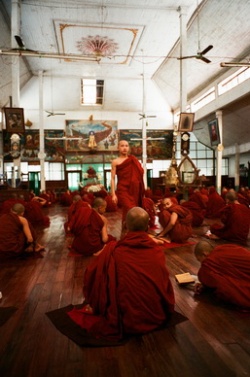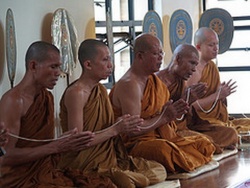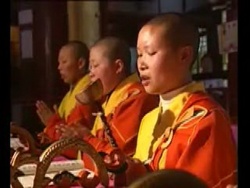Puja Symbolism
Every object associated with the ritual of Puja or worship is symbolically significant. The statue or image of the deity, which is called ‘Vigraha’ (Sanskrit: ‘vi’+ ‘graha’) means something that is devoid of the ill effects of the planets or ‘grahas’. The flower that we offer to the deity stands for the good that has blossomed in us. The fruits offered symbolize our detachment, self-sacrifice and surrender, and the incense we burn collectively stands for the desires we have for various things in life. The lamp we light represents the light in us that is the soul, which we offer to the Absolute. The vermilion or red powder stands for our emotions. Additional and more in-depth offerings are provided below:
Fire
The fire is the protector and messenger between men and gods. Agni, is the Vedic god who personifies the three forms of fire: the sun, lightning, and the sacrificial fire (Yagya).
Lighting Lamps
The traditional oil lamp has a further spiritual significance. The oil or ghee in the lamp symbolizes our negative tendencies and the wick, the ego. When lit by spiritual knowledge, our negative tendencies get slowly exhausted and the ego too finally perishes. The flame of a lamp always burns upwards. Similarly, we should acquire such knowledge as to take us towards higher ideals. Knowledge removes ignorance just as light removes darkness. Knowledge backs all our actions whether good or bad. We therefore keep a lamp lit during all auspicious occasion as a witness to our thoughts and actions
Water
Because of its constant motion and sound, and its power, water is believed to be a living force. In addition, many lakes, rivers, and other water bodies had healing powers, which made water even more mystics. Sipping water and being sprinkled with water are essential to many sanskaras and symbolize ceremonial bathing.
The Lotus
The holiest of flowers for Hindus, the beautiful lotus is symbolic of the true soul of an individual. It represents the being, which lives in turbid waters yet rises up and blossoms to the point of enlightenment. The lotus blooms with the rising sun and close at night. Similarly, our minds open up and expand with the light of knowledge. The lotus grows even in slushy areas. It remains beautiful and untainted despite its surroundings, reminding us that we too can and should strive to remain pure and beautiful within, under all circumstances. Mythologically speaking, lotus is also a symbol of creation, since Brahma, the creator came forth from the lotus that blooms from the navel of Vishnu. The lotus is the symbol of truth, auspiciousness and beauty (satyam, shivam, sundaram).
Kalash
A kalash (or lota) is a brass, mud or copper pot filled with water. Mango leaves are placed in the mouth of the pot and a coconut is placed over it. A red or white thread is tied around its neck or around it. When the pot is filled with water or rice, it is known as purnakumbha representing the inert body (shiva) which when filled with the divine life force gains power to act (shakti). The water in the kalash symbolises the primordial water from which the entire creation emerged. The leaves, life, and coconut represent divine consciousness. The thread represents the love that “binds” all in creation. Commonly used during almost all religious rites, the pitcher also stands for the Goddess Lakshmi.
Coconut
The water in the Purnakumbha and the coconut have been objects of worship since the Vedic age. The coconut (Sanskrit: Sriphala = God’s fruit) alone is also used to symbolize ‘God/dess’. While worshipping any deity, a coconut is almost always offered along with flowers and incense sticks. In India one of the most common offerings in a temple is a coconut. It is also offered on special occasions like weddings, festivals etc. It is offered in the sacrificial fire whilst performing homa. The coconut is broken and placed before the Creator. It is later distributed as Prasad. The three ‘knots’ on the coconut allow it to represent the Three-eyed Lord Shiva (fulfillment of desires), and/or the human head. As such, it is used in ritual to symbolizing:
The breaking of the ego (cracking of the nut)
The inner tendencies (the juice)
The mind (the white meat
Tender coconut water is used in abhisheka rituals since it is believed to bestow spiritual growth on the seeker. The coconut also symbolises selfless service. Every part of the tree is used in innumerable ways (home construction, food dishes, oil, soap etc. It can also take salty water from the earth and converts it into sweet nutritive water.
OM
Om is an auspicious sound that was chanted by the Lord before creating the world. It represents the world and the Truth behind it. It is the universal name of the Creator, made up of the letters A, U and M. The three letters symbolize:
The three states (waking, dream and deep sleep), <
The three deities (Brahma, Vishnu and Shiva
The formless Lord (Brahma) is represented by the silence between two Om Chants
The three Vedas (Rig, Yajur and Sama),
The three worlds (Bhuh, Bhuvah, Suvah) etc. Om is written in different ways in different places. The most common form symbolises Lord Ganesha. The upper curve is the head; the lower large one, the stomach; the side one, the trunk; and the semi-circular mark with the dot, the sweet-meat ball (modaka) in Lord Ganesha’s hand. Thus om symbolises everything – the means and the goal of life, the world and the Truth behind it, the material and the Sacred, all form and the Formless. During ceremony/puja, when the conch is blown, the primordial sound of Om emanates. As the story goes, when the demon Shankhaasura defeated the Devas, he took the Vedas and went to the bottom of the ocean. The devas appealed to Lord Vishnu for help. He incarnated as Matsya Avataara – the “fish incarnation” and killed Shankhaasura. Lord Vishnu then blew the conch-shaped bone of the demond’s ear and head, producing the sound AUM, from which emerged the Vedas. Therefore, all knowledge enshrined in the Vedas is an elaboration of Om. Lord Vishnu is often depicted carrying the Sankha at all times in one of His four hands. It represents dharma or righteousness, one of the goals of life. The sound of the conch is thus also the victory call of good over evil. It is believed that if the Shankha is blown with skill, it can scare away evil spirits and is described as a killer of germs and enemies. The Hindus as well as the Buddhists drink water from a Shankha before they break a fast and almost all temple prayers are accompanied by the blowing of the Shankha.
Aarati
Towards the end of every ritualistic worship of the Creator, or to welcome an honoured guest, we perform the aarati. This is always accompanied by the ringing of the bell and sometimes by singing, playing of musical instruments and clapping. To perform aarati, hold the lighted lamp in the right hand, and circle the representation of the Devine, or the person who is being honoured clockwise three times. As the light is waved we either do mental or loud chanting of prayers or simply behold the beautiful form of the Devine. The symbolism is similar to that of the moon/sun circling us. As the light moves above the statue or person, it appears engulfed in darkness, but as the light moves around the statue there is enlightenment. The act of aarati reveals to us the divinity within each of us with the help of the “flame” of knowledge (or the light of spiritual knowledge). At the end of the aarati, we place our hands over the flame and then touch our eyes and the top of the head. It means – may the light that illuminated the Lord light up my vision; may my vision be divine and my thoughts noble and beautiful. Aarati is often performed with camphor. This holds a telling spiritual significance. Camphor when lit, burns itself out completely without leaving a trace of it. It represents our inherent tendencies (vaasanas). When lit by the fire of knowledge which illumines the Creator (Truth), our vaasanas thereafter burn themselves out completely, not leaving a trace of ego which creates in us a sense of individuality that keeps us separate from the Creator. Also while camphor burns to reveal the glory of Creator, it emits a pleasant perfume even while it sacrifices itself. In our spiritual progress, even as we serve the guru and society, we should willingly sacrifice ourselves and all we have, to spread the “perfume” of love to all. We often wait a long while to see the illumined Creator but when the aarati is actually performed, our eyes close automatically as if to look within. This is to signify that each of us is a temple of the Creator. This chant speaks of the Creator’s existence in darkness, the unknown, but that the smallest light, can lead to further illumination. The philosophical meaning of aarati extends further. The sun, moon, stars, lightning and fire are the natural sources of light. The Creator is the source of these wondrous phenomenon of the universe. It is due to Him/Her alone that all else exist and shine. As we light up the Creator with the flame of the aarati, we turn our attention to the very source of all light which symbolises knowledge and life. Also the sun is the presiding deity of the intellect, the moon, that of the mind, and fire, that of speech. The Creator is the supreme consciousness that illuminates all of them. Without Him/Her, the intellect cannot think, nor can the mind feel nor the tongue speak. The Creator is beyond the mind, intellect and speech. How can these finite equipment illuminate the Creator? Therefore, as we perform the aarati we chant;
Na tatra suryo bhaati na chandra taarakam
Nemaa vidyuto bhaanti kutoyamagnib
Tameva bhaantam anubhaati sarvam
Tasya bhasa sarvam idam vibhaatiThis chant speaks of the Creator’s existence in darkness, the unknown, but that the smallest light, can lead to further illumination.
Prasad
It is our ignorance, which we offer to the deity in a Puja through the use of food with the intent that the Creator will empower it with spiritual enlightenment. After he suffuses it with knowledge and light and breathes new life into the Prasad, we then bring divinity into our bodies as intake the Prasad. By offering this gift to others, we share the knowledge we thus gained with fellow beings.
Food Offerings
Before we partake of our daily meals we first sprinkle water around the plate as an act of purification. Five morsels of food are placed on the side of the plate acknowledging the debt owed by us to: (Devta Runa) -The Divine forces, for their grace and protection;
(Pitru Runa) – The ancestors, for our lineage and family culture;
(Rishi Runa) – The sages, for the teachings they manifest, and pass down to us; (Manushya Runa) – All beings without the support of which we could not live as we do and other living beings (bhuta runa) for serving us selflessly.
The Creator and life force, who is also within us.The offerings is made with this chant, and then eaten as Prasad, blessed food:praanaaya swaahaa,
apaanaaya swaahaa,
vyaanaaya swaahaa,
udaanaaya swaahaa,
samaanaaya swaahaa,
brahmane swaahaa Tilak
The tilak cover the spot between the eyebrows, which is the seat of memory and thinking. It is known as the Aajna Chakra in the language of Yoga. The tilak is applied with the prayer – “May I remember the Creator. May this pious feeling pervade all my activities. May I be righteous in my deeds.” Even when we temporarily forget this prayerful attitude the mark on another reminds us of our resolve. The tilak is thus a blessing of the Creator and a protection against wrong tendencies and forces. The entire body emanates energy in the form of electromagnetic waves – the forehead and the subtle spot between the eyebrows especially so. That is why worry generates heat and causes a headache. The tilak and pottu cools the forehead, protects us and prevents energy loss. sometimes the entire forehead is covered. Shaanti (thrice repeated Mantra)
Shaanti, meaning “peace”, is a natural state of being. Disturbances are created either by us or others. For example, peace already exists in a place until someone makes noise. It is believed that trivaram satyam – that which is said thrice, comes true. We chant shaanti thrice to emphasise our intense desire for peace. It is chanted aloud the first time, addressing the unseen forces. It is chanted softer the second time, directed to our immediate surroundings and those around, and softest the last time as it is addressed to oneself. All obstacles, problems and sorrows originate from three sources. Aadhidaivika : Divine Factors: Earthquakes, floods, volcanic eruptions etc. Aadhibhautika: External Factors: Weather, crime, media.
Aadhyaatmika : Internal factors: Stress, health, etc.




